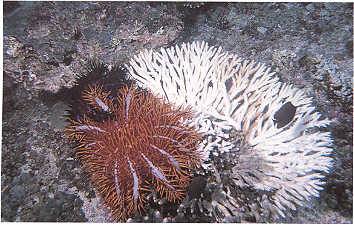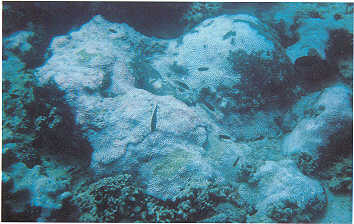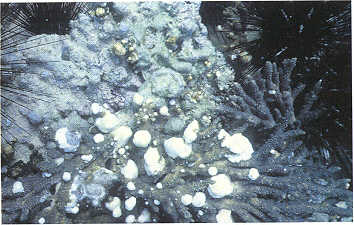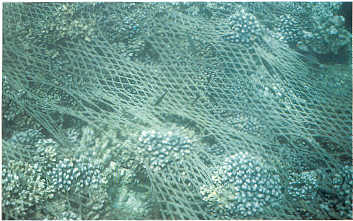
Natural and man-related disturbances to Oman's corals and coral reefs
The stressful temperature environment described in Chapter 4 is one of many factors that may limit the viability and development of corals and coral reefs in Oman's waters. Other natural influences such as competition with or predation from other bottom living organisms, possible toxic effects from blooms of algalplankton and unexplained outbreaks of coral diseases have all been experienced by Oman's coral communities in recent years. Man-related impacts from nearshore gill net fishing, boat anchoring and sport diving are all undetermined in terms of their seriousness as negative factors on coral vitality. Fishing and diving have increased dramatically in the last ten years in Oman and are likely to continue at an even higher rate with increasing population, prosperity and modernization of the country. In this chapter we will describe some of the negative influences on coral reefs that have occurred in Oman and attempt to evaluate their respective importance as threats to coral reef survival and development.
Probably the most publicised natural danger to reef corals world wide has been the Crown of Thorns starfish Acanthaster planci. This is the largest of the starfish, growing up to 0.5 m in diameter and sometimes having more than 20 arms. It feeds exclusively on corals by everting its stomach through its mouth on to the live coral surface and directly digesting the coral's tissue. The Crown of Thorns achieved fame during the 1970's and 80's when it underwent dramatic population increases on many coral reefs in the tropical Pacific, especially on the Great Barrier Reef, Guam, Tahiti and Hawaii. In these and other areas where its population rapidly increased, great numbers of Crown of Thorns starfish virtually stripped large areas of reef of live corals, leaving behind dead coral skeletons.
This devastation of reefs prompted
serious concern at the time that such unprecedented destruction would permanently
degrade the coral reef environment and seriously affect the people
living on low-lying coral atolls. Both the wave protection and
the fisheries habitat that is provided by coral reefs are an essential
part of both the culture and the economies of many tropical island
nations.

Programs of both study and eradication initiated in the 1970s have greatly increased our knowledge of the Crown of Thorns and its impact on coral reefs. Although we still do not know what induces the outbreaks of the starfish, there is now good evidence that such outbreaks have occurred repeatedly in the past. On the Great Barrier Reef where the most extensive reef damage was seen 25 years ago, and which has received the greatest amount of study, coral populations have re-established themselves, and the coral community appears to be normal. It may be that the periodic outbreak of Crown of Thorns populations may be a normal and necessary event for maintaining high coral species diversity on reefs by preventing the monopolization of habitat space by those coral types which compete best over the long term.
In Oman it is interesting that concern over sightings of Crown of Thorns starfish were the motivation for the first survey of Oman's corals and reefs, performed by Dr Peter Glynn in 1982 under sponsorship of Oman's Ministry of Agriculture and Fisheries. This study extended from the Musandam to Dhofar and determined that Crown of Thorns were not abundant in most of Oman's coral growing areas at that time. The greatest starfish concentrations were in the Damaniyat Islands and in Bandar Jissah, where up to 42 starfish were counted, and their recent feeding scars could be seen on many corals. No mass infestations of starfish were observed, and the study concluded that Crown of Thorns was not a threat to Oman's corals or reefs.
Recent extensive suveys in 1992-94 of the entire rocky shore coastline in the Muscat Area and the Dimaniyat Islands concurred with the findings of the 1982 study. Of a total of 517 transects along the shoreline and offshore islandsfrom Qurm to Bandar Khayran, Crown of Thorns was seen on only two transects, or less than 1%. In the Dimaniyat Islands the starfish was more abundant, occurring on 11of 84 transects, or 13%. Feeding scars were also more common on corals in the Damaniyats than along the Capital Area shoreline, but feeding scars were only on selected coral species. No indication has been found of mass feeding on corals by Crown of Thorns starfish in Oman, nor any evidence that starfish populations have ever risen above modest numbers.
Other isolated disturbances have recently taken place on corals in the Muscat area which are more difficult to explain than Crown of Thorns predation, but which apparently have also occurred in the past. In October 1993 most of the corals at depths of 5 to 10 m in the "Bill's Bumps" bay north of Al Fahl Island showed a condition known as "White Band Disease" in which most of the live tissue on a coral head rapidly decomposes and sloughs off the coral skeleton, leaving a coral head partly alive but with the skeleton partly exposed. On sufaces of corals where this condition has been recognised the exposed skeletonis pure white, but it becomes coated with sediment and algae with time, while the part of the coral which retains tissue continues to grow, resultingin strangely shaped corals with large cavities in their skeletal bases.

The White Band Disease condition was first described for cor:als from the Caribbean in the 1970's and has been reported in many parts of the world, including the Red Sea. There is, as yet, no known physical or biological explanation for the condition, and it is usually found in limited and isolated circumstances, although White Band Disease has recently been reported to be a serious factor in the decline of the dominant reef forming Acroporid species in the Caribbean. In the case of the Al Fahl Island incident, the outbreak took place at the end of an especially intense season of upwelling when strongly elevated dissolved nutrient concentrations and blooms of toxic phytoplankton were measured in the Capital Area, and shallow areas around Al Fahl Island were highly affected by water from upwelling (Chapter 4). Whether these upwelling effects were important in this particular White Band Disease episode can not be determined. However, many corals in shallow water in the Musandam show the same misshapen growth that results from an occurrence of White Band Disease, suggesting that upwelling effects are not necessary for this condition to occur.
Another even more unusual and infrequent
coral disease that also has been previously reported elsewhere has occurred
at two sites in Bandar Khayran. This is a cancerous condition where the
growing tissues of corals lose their normal tissue structure and their
capability to deposit calcium carbonate in a normal manner to form normal
calycal and basal structures. Instead, these corals deposit skeleton as
spherical tumorous masses which have only a thin overlying tissue layer
with no zooxanthellar pigmentation. These colorless
skeletal tumors begin as smal lumps at the base of a branch, but their
rapid growth and proliferation results in the dominance of an infected
coral by tumors up to 5 cm in diameter and a dead zone which spreads
from the center of the coral outwards. This condition has been reported
for a variety of coral species in many parts of the world. Tumor
development has always been confined to small areas of reef and a limited
number of corals, and no factor has been identified which may induce the
formation of these tumors.

It may well be that certain corals in a population are genetically prone to develop these tumors in response to an as yet undetermined environmental stimulus. One candidate for such a stimulus might be a lack of pigments and compounds in a tumorous coral's tissue which would normally provide protection from ultra-violet radiation that reaches corals in abundance on a reef. However, recent measurements that have been made on tumorous corals in Oman have indicated that the concencentrations of these ultra-violet absorbing compounds are as high in the colorless tissues of tumors as in tissues from normal corals.
In Oman the cancerous corals at Bandar Khayran were of two species of Acropora, Table Coral and Bush Coral. Table Corals with tumors were first found in May 1992 in a small area only a few meters from the beach near the road entrance to Bandar Khayran. By January 1994 virtually all the Table Corals (Acropora clathrata) on an area of about 2.5 square meters on this reef had tumors in various stages of development and many corals were in a state of decline. The growth and proliferation of these tumorous corals were studied until January 1994 when all corals on the entire reef were killed by freshwater runoff during a massive rainstorm. In May 1994 more corals with tumors were discovered at depths from 0.3 to 3.3 m just inside of the small island that lies about 1.5 km offshore of the road entrance to Bandar Khayran. These were all Bush Coral (Acropora valida) and they were more widespead on the reef; occurring on about 150 square meters of bottom. However, tumorous corals were more intermittent in this affected area and mortality of these affected corals by January 1995 did not appear to be nearly as complete as previously observed for the table corals at the first site.
Both White Band Disease and coral tumor formation are interesting conditions that have thus far occurred infrequently in Oman and in isolated circumstances, similar to the manner in which this condition has been reported elsewhere in the world. As such, these diseases cannot be considered important threats to survival and growth of corals or reef development. A more widespread disturbance to corals and reefs that is especially common in Oman is related to the fishing methods that are presently most in use there. The most common method of nearshore fishing is by gill nets which are deployed by the hundreds In shallow nearshore areas and left for long periods of time. When nets break loose from their moorings they may drift onto reefs or areas of coral growth and become entangled on large areas of live corals. Derelict nets are especially common in embayments or on the leeward sides of islands where they come to rest in the quiet water where corals are usually most abundant. In 1992-1994 surveys conducted on the Capital Area shoreline and offshore islands from Ourm to Bandar Khayran more than 27 derelict nets were found on 25% of the 109 transects which were in areas of active coral growth.

What has not been determined is just how damaging these nets are to the reef corals which they entangle and cover. Certainly a reef which has an aging and decaying net lying over it is much less aesthetically pleasing to dive upon and view than one in its natural state. However, the damage that is imparted by these nets to live corals or reef growth has yet to be measured and no definite conclusions can be drawn. Preliminary observations made on many of these net impacted coral beds suggest that the corals can continue to live and grow, eventually growing above the nets as the nets age and decompose. In many areas live corals project through nets which have apparently been in place for long periods of time and are in advanced state of decay, while the corals appear to be in a healthy condition. The exception to this occurs when nets entangle corals in areas of active wave disturbance. Dr Rod Salm has described this situation at a site in the Daymaniyat Islands, where nets under wave action have destroyed or damaged 25 to 80% of the Cauliflower Coral (Pocillopora damicomis) entangled on reefs, tearing the live corals from their bases.
The potential damage to reef coralsfrom
net entanglement is therefore dependent on specific conditions at individual
sites. However, derelict nets will always represent a direct threat to
fishes through "ghost fishing" of fishes that continue to get trapped in
the net's mesh and lost both to the fish
population and to the fisherman. As
fishing effort along Oman's coast continues to increase, the total environmental
impacts from lost nets could become more serious. From time to time
dive clubs in the Capital Area have organized net removal efforts
that have temporarily reduced the numbers of derelict nets in local reefs
and areas of coral growth. These activities show a commendable concern
for the aesthetics and ecology of the local coral environment. However,
the manner in which the nets are removed is important. If care were not
taken to avoid damaging entangled corals in the process of removing
nets, their removal might prove to be more harmful than leaving the nets
in place to decompose and eventually be overgrown by the corals.
Again,
no information is available to evaluate the effectiveness of these net
removal efforts for protecting corals and reefs.
Boat anchoring represents another potentially serious impact to reefs and coralsthat may increase with time unless preventative measures are taken. Damage to live coral caused by a single occurence of pulling up a stuck anchor on a reef may require years of coral growth to repair. A system of boat mooring bouys in the vicinity of frequently visited coralareas has been discussed for many years for the Capital Area. Installation of these bouys would provide needed protection as boat usage and anchoring in these areas increases in the future. Other impacts to corals and reefs that could increase with diving activities are damage from physical contact of divers swimming close to the reef and the handling of corals and other marine organisms. Most coral growing areas in Oman are on relatively low relief slopes rather than sheer walls. The corals are, therefore, susceptible to diver impacts such as being trampled on, knelt on, or exposed to sediments resuspended by diver's fin movements. At present the level of diving activities in Oman is low, and there are no reported indications of reef damage by dIver impact. However, if Oman develops more of a tourist based economy, which will surely include diving oriented visitors, diver related impacts could be of concern, especially considering that relatIvely few prime dIve spots will probably receive the major portion of the visitors.
Oman is fortunate in that relatively little water borne pollution reaches its coastal waters that could affect reef corals or other sensitive marine organisms. No sewage, treated or untreated, is discharged into the ocean, no industrial effluents are released, and freshwater runoff seldom occurs that can lower seawater salinity or increase sedimentation to levels not tolerated by marine organisms. Large volumes of high temperature brine are released as effluent from desalination and electricity production at Al Athaiba in the Capital Area, but this area is remote from areas of coral growth and reef habitats. One source of water pollution that might significantly affect reef corals is the potential impact of petroleum hydrocarbon pollution from oil spills at sea. More than half the world's ocean transported crude oil passes through the Strait of Hormuz and along Oman's coast. Also, crude oil is loaded into tankers offshore of Mina Al Fahl, only about 5 km from one of Oman's most pristine and diverse coral areas in the vicinity of Al Fahl Island. To date no major spills have occurred at this terminal which have had any reported impact on the Al Fahl Island reefs, a commendable record that we hope will continue .
In regard to offshore oil spills, it appears that, to date, these have occurred without recognizable impacts on Oman's corals and reefs. This is primarily due to the fact that spilled oil remains on the surface of the water, well above the corals growing on the bottom. When an oil spill takes place at sea, much of its volume and toxic compunds rapidly evaporate to the atmosphere in a few days, leaving a residue of tar floating on the sea surface that will float with wind and currents until it reaches the shore. Here it is evident as beach tar that is a major nuisance to beachgoers and can negatively impact intertidal organisms, especially if the quantity of tar totally covers the shoreline. However, there is little or no evidence to indicate that infrequent oil spills and tar significantly damage adult corals or other shallow water organisms, even when the spills are massive. Observations made following the Kuwait War indicated that the largest oil spill in history had not visibly affected corals, reefs or other sensitive benthic communities right up to the shoreline in the northern Arabian Gulf. No effects were observed or reported on Capital Area corals or reefs from an offshore oil spill that produced up to 11 kg of beach tar per meter of shoreline in November 1993 in the Muscat area.
It should be noted that oil pollution can be a major threat to the long term vitality of corals and other reef organisms by affecting their reproductive and early life stages. The eggs, sperm and fertilized gametes of recently spawned corals rise to the water's surface and remain at shallow depths for various times before they settle. Since oil concentrations and toxic compounds are at their maximum at the water surface, oil slicks have high potential of producing toxic or lethal effects on the coral's vulnerable young stages, as well as to larvae of other organisms. Therefore, long term damage to coral communities has been reported for areas where oil spills are continuous or frequent and in enclosed embayments such as for oil terminals in the Gulf of Aqaba, and the impact has been shown to be greatest on coral reproductive processes.
For the most part and to the present time the generalization can be made that Oman's corals and reefs are in good condition and relatively unaffected by man-related pollution or destructive impacts that have come to affect reefs in other parts of the world. Oman's nearshore areas have a unique coral community that lives under unusual conditions of natural temperature stress, and the habitat provided by corals and coral reefs for other marine invertebrates and abundant fishes is one of the most valuable natural resources of Oman. We sincerely hope that the readers of this book will have become more aware of the beauty and importance of this resource and will be influenced to help maintain and protect Oman's corals and reef environment.